Best Selling Authors Coming to Scarsdale Adult School: Sign Up Now
- Details
- Written by: Joanne Wallenstein
- Hits: 2133
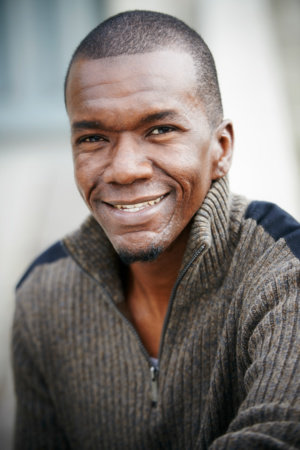 More authors than ever before are flocking to Scarsdale Adult School for special in-person or online visits for our students. First up this fall is an online double feature on Thursday, September 29, 2022. The afternoon headliner is Ann Leary, The Foundling (2022) (Course 11435), speaking at 1 pm about her new historical fiction. Set in 1927 in a public asylum founded to sequester "feebleminded women of childbearing age," The Foundling portrays the moral dilemma faced by a young secretary whose loyalty to her brilliant employer, a psychiatrist who had been at the forefront of the women's suffrage movement, is tested by a friend from the past, an inmate seeking to escape from the institution. In the evening at 7 pm, meet Ellen Jovin, Rebel with a Clause: Tales and Tips from a Roving Grammarian (2022) (Course 11510) for an entertaining recounting of her favorite grammar adventures and answers to all pressing questions on proper sentence structure.
More authors than ever before are flocking to Scarsdale Adult School for special in-person or online visits for our students. First up this fall is an online double feature on Thursday, September 29, 2022. The afternoon headliner is Ann Leary, The Foundling (2022) (Course 11435), speaking at 1 pm about her new historical fiction. Set in 1927 in a public asylum founded to sequester "feebleminded women of childbearing age," The Foundling portrays the moral dilemma faced by a young secretary whose loyalty to her brilliant employer, a psychiatrist who had been at the forefront of the women's suffrage movement, is tested by a friend from the past, an inmate seeking to escape from the institution. In the evening at 7 pm, meet Ellen Jovin, Rebel with a Clause: Tales and Tips from a Roving Grammarian (2022) (Course 11510) for an entertaining recounting of her favorite grammar adventures and answers to all pressing questions on proper sentence structure.
On Thursday, October 13, 2022, SAS proudly presents a day/night double-header over Zoom with Jason Mott, (pictured at top) author of last year's National Book Award Winner, Hell of a Book (2021). The novel's narrator is an unnamed Black author who is on a cross-country publicity tour to promote his bestselling debut novel, also titled Hell of a Book. He converses with an imaginary ever-present youngster he refers to as "The Kid." Interwoven in this plotline, is the heart-wrenching tale of a rural Southern boy called "Soot" because of his dark complexion. With magical realism, sardonic humor, and a converging narrative, this masterful fiction addresses themes of racism, police violence, love, money, and the experience of growing up Black in America. At 1 pm, Mott himself will moderate a book group in Author-Led Book Discussion: Jason Mott, Hell of a Book (2021) (Course 11520). Class size is limited for this bespoke event. At 7 pm, Mott returns for a community-wide program, Author Visit: Jason Mott, Hell of a Book (2021) (Course 11521). In conversation with cultural historian Lori Rotskoff, Mott will discuss his career as a writer of fiction and poetry with time reserved for audience Q&A. The evening program will be recorded and available to all registered students.
On Friday, October 21, 2022 at 11 am at Westchester Reform Temple, SAS hosts Author-Led Book Discussion: S.W. Leicher, Acts of Atonement (2022) (Course 11515). The sequel to her debut novel, Acts of Assumption (2018), her latest book again features protagonists and partners Serach Gottesman, a soft-spoken renegade from Ultra-Orthodox Jewish Brooklyn, and Paloma Rodriguez, a headstrong, trailblazer from the Latina South Bronx, who sacrificed their families, communal ties, and faiths in pursuing their forbidden romance. An unexpected death, a seductive offer, and an arrest bring their estranged relatives 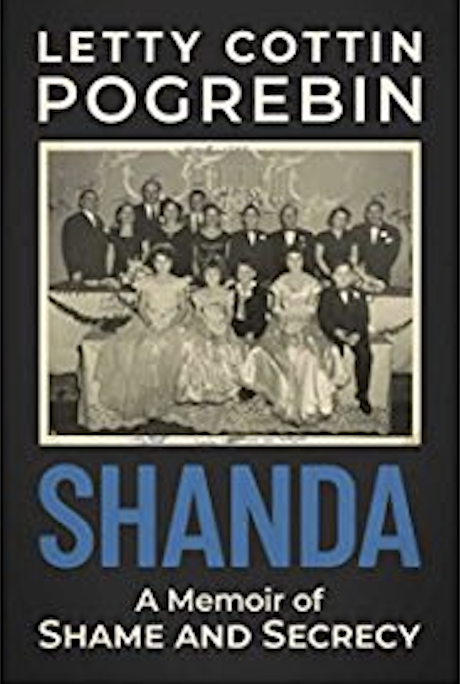 and insular cultures back into their lives with devastating results.
and insular cultures back into their lives with devastating results.
On Thursday, October 27, 2022 at 12:30 pm at JCC of Mid-Westchester, the co-founder of Ms. magazine, Letty Cottin Pogrebin, returns to SAS to discuss her newly published memoir in conversation with Lori Rotskoff. Shanda: A Memoir of Shame and Secrecy (2022) presents a wise yet funny self-examination of the author's numerous family secrets across three generations. Time will be reserved for Q&A and Pogrebin will be signing books after the talk. Students may register for either General Admission plus Book Purchase (Course 11453) or General Admission Only (Course 11452).
On Tuesday, November 1, 2022 at 7:15 pm at Scarsdale High School, Bobbi Rebell, personal finance expert and author of Launching Financial Grownups (2022), offers tips and tools for parents of teens and young adults who want their children to grow into fiscally responsible and financially independent adults. Students again have the choice between General Admission plus Book Purchase (Course 11498) or General Admission Only (Course 11529).
On Monday, November 7, 2022 at 1 pm, SAS welcomes Bonnie Garmus, who will discuss her debut bestselling novel, Lessons in  Chemistry (2022), in conversation with cultural historian Lori Rotskoff. Set in the 1960s, Elizabeth Zott, the book's formidable feminist and idiosyncratic heroine, begins as a brilliant research chemist in a male-dominated field and becomes a single mother and reluctant star of a beloved cooking show. Deftly blending sharp social satire with heartwarming humor, Garmus delivers a self-assured page-turner that tackles the sexism of postwar America from a fresh perspective. Author Visit: Bonnie Garmus, Lessons in Chemistry (2022) (Course 11436) will be recorded and available for later viewing by all registered students.
Chemistry (2022), in conversation with cultural historian Lori Rotskoff. Set in the 1960s, Elizabeth Zott, the book's formidable feminist and idiosyncratic heroine, begins as a brilliant research chemist in a male-dominated field and becomes a single mother and reluctant star of a beloved cooking show. Deftly blending sharp social satire with heartwarming humor, Garmus delivers a self-assured page-turner that tackles the sexism of postwar America from a fresh perspective. Author Visit: Bonnie Garmus, Lessons in Chemistry (2022) (Course 11436) will be recorded and available for later viewing by all registered students.
To close out the year, on Tuesday, December 13, 2022 at 11 am, the bestselling author of Wench and Balm, Dolen Perkins-Valdez will engage in conversation with cultural historian Lori Rotskoff to discuss her latest unforgettable historical epic in Author Visit: Dolen Perkins-Valdez, Take My Hand (2022) (Course 11526). Inspired by true events involving Black women’s involuntary sterilization in Alabama during the 1970s, Take My Hand is a profoundly moving novel about a Black nurse in post-segregation Alabama who blows the whistle on a terrible wrong done to her patients. The book sheds a timely light on issues of voice, choice, and agency over one's body. Time will be reserved for Q&A.
Register for all at www.ScarsdaleAdultSchool.org or call 914-723-2325 with questions.
Fighters for Women’s Reproductive Health Rallied in Scarsdale to Support WCLA-Choice Matters
- Details
- Written by: Michelle Sterling
- Hits: 2324
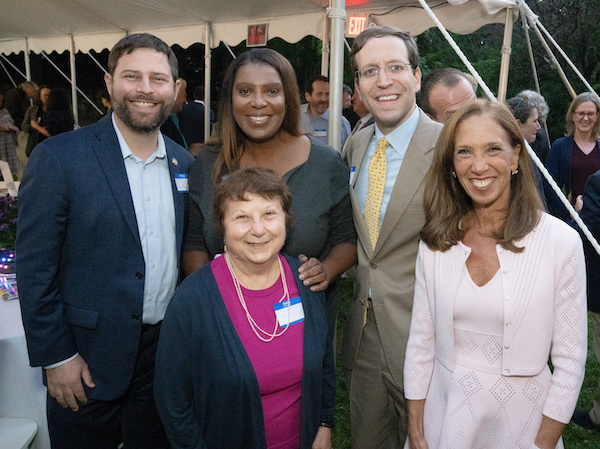 Attorney General Letitia James, Senator Chuck Schumer, Lieutenant Governor Antonio Delgado and New Yorkers from throughout Westchester County gathered last week to support the fight for a woman’s right to choose and support WCLA Choice Matters – one of the most accomplished pro-choice organizations in New York State. James spoke eloquently about her experiences, the necessity of women having empowerment over their own bodies, and what she is doing about it in the AG’s office.
Attorney General Letitia James, Senator Chuck Schumer, Lieutenant Governor Antonio Delgado and New Yorkers from throughout Westchester County gathered last week to support the fight for a woman’s right to choose and support WCLA Choice Matters – one of the most accomplished pro-choice organizations in New York State. James spoke eloquently about her experiences, the necessity of women having empowerment over their own bodies, and what she is doing about it in the AG’s office.
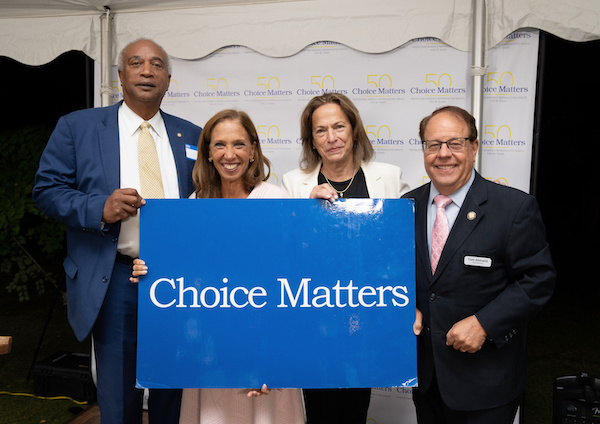 Left to right: NYS Assemblymember Gary Pretlow, NYS Assemblymember and Scarsdale resident Amy Paulin, WCLA Choice Matters President Catherine Lederer-Plaskett, NYS Assemblymember Tom Abinanti
Left to right: NYS Assemblymember Gary Pretlow, NYS Assemblymember and Scarsdale resident Amy Paulin, WCLA Choice Matters President Catherine Lederer-Plaskett, NYS Assemblymember Tom Abinanti
Schumer spoke movingly about his experiences over the years with the women’s movement and WCLA activists in particular. Delgado spoke about what the fight means for all New Yorkers and urged residents to vote. Former Senator Nita Lowey spoke about her history with the movement, and her continued support.
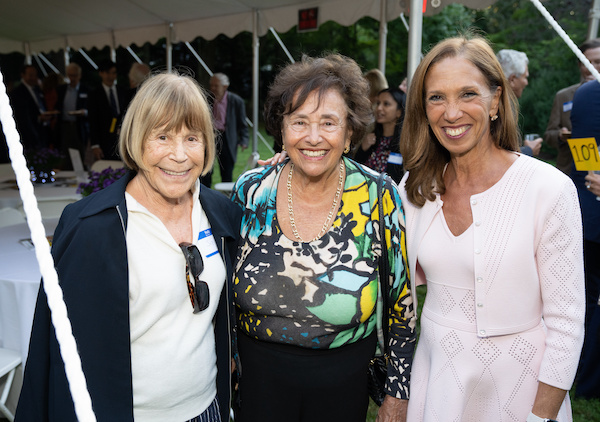 Left to right: Former NYS Senator Suzi Oppenheimer, Former U.S. Congresswoman Nita Lowey, NYS Assemblymember and Scarsdale resident Amy Paulin
Left to right: Former NYS Senator Suzi Oppenheimer, Former U.S. Congresswoman Nita Lowey, NYS Assemblymember and Scarsdale resident Amy Paulin
Many others spoke about their current fight to bring reproductive rights back to women on the local, state and national level. Retiring Assembly members Sandy Galef and Tom Abinanti were awarded for their many years of service fighting for women and families, and Assembly member Amy Paulin, a perennial leader in women’s issues, gave heartfelt introductions and hosted the event. “The fight for reproductive rights continues,” said Paulin. “It’s a marathon, but I’ll never give up the battle. We’ve made New York State a safe haven for women and we’re not only going to keep it that way, but we’re going to continue to expand on it in every we can.” To support WCLA - Choice Matters please click here.
(Pictured at top: NYS Senator Elijah Reichlin-Melnick, NYS Attorney General Letitia James, Former NYS Assemblymember David Buchwald, NYS Assemblymember and Scarsdale resident Amy Paulin, Front: White Plains Common Council member Victoria Presser.)
Photo Credit: Don Pollard
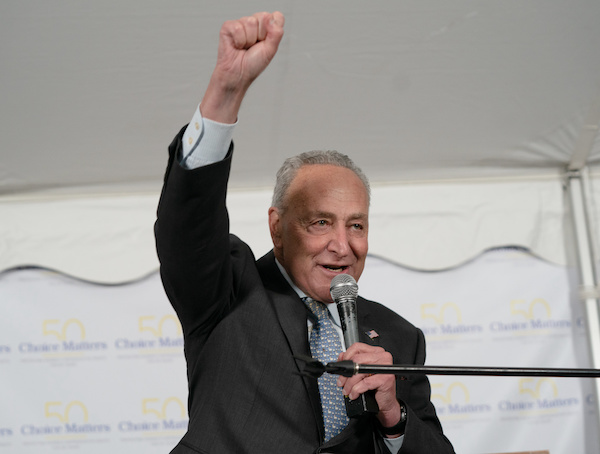 Chuck Schumer
Chuck Schumer
Scarsdale Parents Greet Hometown Heroine Dr. Becky
- Details
- Written by: Joanne Wallenstein
- Hits: 10139
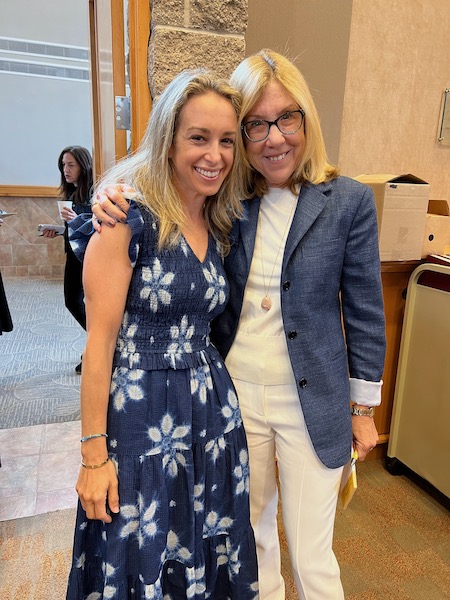 Dr. Becky with Mom Debbie PrinceScarsdale native and parenting guru, Dr. Becky Kennedy, aka Becky Prince in the ‘dale, returned to her hometown on September 12, 2022 to launch her first book and greet over 150 fans at an event sponsored by the UJA at Shaarei Tikvah.
Dr. Becky with Mom Debbie PrinceScarsdale native and parenting guru, Dr. Becky Kennedy, aka Becky Prince in the ‘dale, returned to her hometown on September 12, 2022 to launch her first book and greet over 150 fans at an event sponsored by the UJA at Shaarei Tikvah.
In just two years, “the parenting whisperer” has amassed 1.3 million followers on Instagram, who turn to her for help on managing their children, their families and their own emotional health. She has built an impressive brand around “Good Inside,” that includes podcasts, videos, a newsletter, daily emails and now her first book.
A clinical psychologist, Dr. Becky noticed that patients would come to her practice and say they had great parents but nonetheless, they felt empty, unsatisfied, and like nothing was ever good enough. She realized that they were no more able to deal with disappointment at the age of 18 than they were at the age of 2, sometimes because they were unable to process their own feelings. She said, “In order to deal with a feeling you have to feel it.”
She developed a new parenting paradigm that begins with the premise that everyone, both parents and children, are good inside. Rather than seek to control bad behavior through punishments and time-outs, Dr. Becky advises parents to join their kids on their “side of the table,” and to use empathy and reasoning to help children understand and cope with their feelings. By offering them skills to recognize and deal with frustration and hurt, children can craft their own solutions and avoid tantrums, acting out or hurting others or themselves.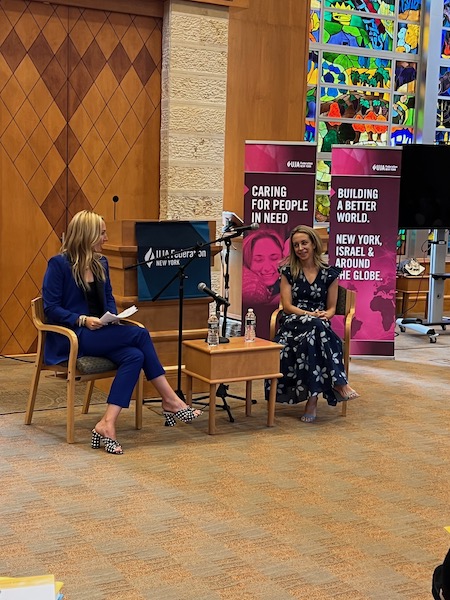 Dr. Becky was interviewed by Lindsay Weinberg, founder of DohLife.
Dr. Becky was interviewed by Lindsay Weinberg, founder of DohLife.
She does not believe it is up to parents to make their children happy. She says, “When things don’t work, don’t jump in and make them happy. Let them find their own happy bench …. We can’t always find happy – let them experience that feeling. As a parent, don’t always solve the problem for your child. Sit with them on the unhappy bench and say – “uh that stinks! I am so glad we’re talking about this – that’s so important.” Build their confidence and say something like, “I remember being six and not being invited to a slumber party.””
According to Dr. Becky, resilience is the ability to tolerate the feelings. Remove the aloneness of the feeling and your children will be able to cope on their own. She urged parents to ask their kids the right questions to help their children find the answers.
For parents, what happens when you do blow up and say things you wish you hadn’t said? Dr. Becky is a big advocate of making a “repair.” She advises you to apologize for what you said, validate your children’s emotions and add connections, understanding and an explanation.
Asked about her own development and rapid evolution in the past two years, Dr. Becky said, “We have 17 women working full time which has been an energizing shift.” She said, “It lights me up inside to connect with the people in the office and our readers. I feel like there is something bigger that “Good Inside” is delivering. This “feels so much bigger than me and my individual home.”
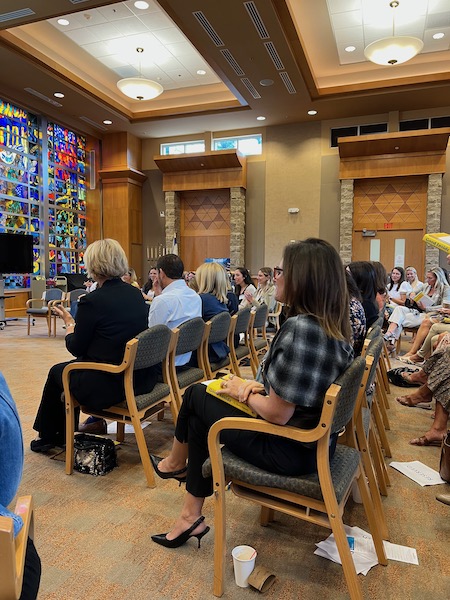 The event attracted over 150 attendees.Dr. Becky admitted that running the business while raising three young children was complicated, but that it gives her a sense of purpose. The following day, she was headed around the country for an eight day national book tour of “Good Inside, A Guide to Becoming the Parent You Want to Be,” at the same time her three children were headed back to their first week of school.
The event attracted over 150 attendees.Dr. Becky admitted that running the business while raising three young children was complicated, but that it gives her a sense of purpose. The following day, she was headed around the country for an eight day national book tour of “Good Inside, A Guide to Becoming the Parent You Want to Be,” at the same time her three children were headed back to their first week of school.
Follow her on Instagram at @drbeckyatgoodinside
The event was sponsored by UJA-Federation of New York who works with a network of hundreds of nonprofits, extending its reach from New York to Israel to nearly 70 other countries around the world, touching the lives of 4.5 million people annually. Every year, UJA-Federation provides approximately $180 million in grants. For more information, please visit ujafedny.org.
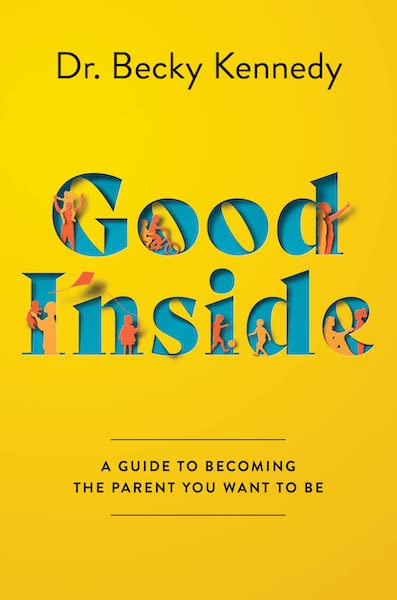
Scarsdale Resident Robert Birnbaum Dies in Taxi Accident
- Details
- Written by: Joanne Wallenstein
- Hits: 4384
 Attorney and Scarsdale resident Robert Birnbaum died in a car accident on the New Jersey Turnpike on the afternoon of Friday August 19, 2022. Birnbaum age 85, was enroute to the airport in a taxi driven by Sayed Tarighati age 69 of Yonkers, who lost control of the Toyota Prius, struck a guardrail and the center concrete barrier, killing both the driver and the Birnbaum.
Attorney and Scarsdale resident Robert Birnbaum died in a car accident on the New Jersey Turnpike on the afternoon of Friday August 19, 2022. Birnbaum age 85, was enroute to the airport in a taxi driven by Sayed Tarighati age 69 of Yonkers, who lost control of the Toyota Prius, struck a guardrail and the center concrete barrier, killing both the driver and the Birnbaum.
An obituary of Birnbaum posted on Legacy.com says the following:
Robert. Robert "Bob" Birnbaum, 85, of Scarsdale NY, died unexpectedly on Friday, August 19th. He was en route to the airport to visit family members when the driver of his taxi lost control of the vehicle.
Bob is survived by Nina, his beloved wife of over 55 years, his daughters Sarah and Beth, and his four grandchildren.
The son of Martin and Esther Birnbaum of Brooklyn, NY, Robert attended NYU University Heights, where he was elected class president, and subsequently Harvard Law School. He spent a long and fulfilling career as a trusts and estates attorney; he had no plans to retire and was a full-time practicing lawyer at the time of his death, finding great meaning and purpose in his work managing the affairs of his clients.
Robert was a classical music lover who enjoyed playing "name that tune" with every symphony he heard on the radio, a voracious reader with a deep interest in history, a curious and adventurous world traveler, and a bon vivant who delighted in a platter of ripe tomatoes and fresh-picked corn. Thanks to his insatiable intellectual curiosity, he served as a search engine in the days before the internet, and the breadth of his knowledge never ceased to astonish - no matter the topic, anyone asking him a question could count on an informed answer.
Throughout their lives, his daughters knew that they could call on him anytime, for anything from sterling advice to a ride home from a questionable party, and he would immediately deliver. His devotion to his family was total, and at the same time his colleagues saw him as endlessly generous with his time. Family, friends, and clients trusted and relied on him for his knowledge, sound judgment, empathy, and kindness. He leaves a gaping hole in the lives of everyone who was lucky enough to know him, and who now will never stop missing him.
A memorial service will be held Sunday, August 28th at 9am at Plaza Jewish Community Chapel, 630 Amsterdam Ave., followed by a shiva gathering at the family's residence at 3pm.
Scarsdale Democrats Greet Candidates at Annual Fundraiser
- Details
- Written by: Joanne Wallenstein
- Hits: 1956
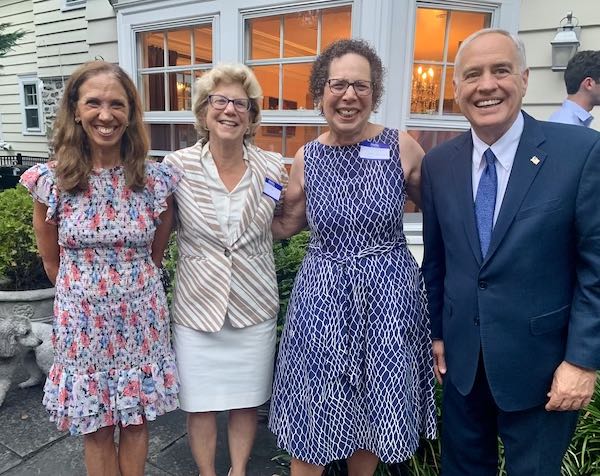 Amy Paulin, Shelley Mayer, Myra Saul and Tom DiNapoli(The following was submitted by Myra Saul, Chair of the Scarsdale Democrat Town Committee)
Amy Paulin, Shelley Mayer, Myra Saul and Tom DiNapoli(The following was submitted by Myra Saul, Chair of the Scarsdale Democrat Town Committee)
The Scarsdale Democratic Town Committee is on a roll. Last year, we set records in raising funds for Fair Fight, the voting rights organization founded by Stacey Abrams, the Democratic nominee for governor in Georgia. This year we had another successful fundraiser for local and state Democratic candidates at our annual event, held last Thursday, August 11. The Scarsdale Committee wishes to thank Assemblywoman Amy Paulin and her husband Ira Schuman for hosting the event at their home and providing the food. We also wish to thank Dean Moretta, owner of Vintology Wine & Spirits, for providing the wine.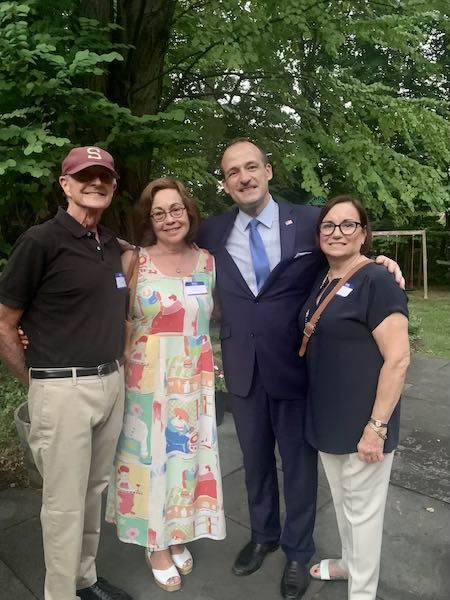 Jon Mark BK Muguia, Vedat Gashi and Carolyn Stevens
Jon Mark BK Muguia, Vedat Gashi and Carolyn Stevens
Unlike last year, when a downpour threatened the event, the crowd enjoyed milder temperatures. Our featured speaker was Tom DiNapoli, New York State Comptroller. In that position, he is a watchdog over the state’s finances and its pension funds. Comptroller DiNapoli is a dedicated public servant and is running for re-election, along with Governor Hochul, Lieutenant Governor Delgado and Attorney General Tish James, on the statewide ticket. We also heard remarks from our likely new state senator, Shelley Mayer, and Assemblywoman Paulin.
The unified message of the speakers: our New York Democratic executive leadership and legislature is doing an excellent job and deserves re-election, in what may be a challenging election year. Your vote is important and every vote counts! Democrats can’t rest because of prior wins; make sure to vote!
To name just a few successes of state Democrats: Democrats have been fiscally responsible with the funds made available through federal Covid programs and prudent overall. Democrats have fortified the rights of women to bodily autonomy in New York with a series of laws in the wake of the Dobbs decision. Despite the Supreme Court’s rejection of New York’s concealed carry law, new gun safety laws are on the books in New York to protect public spaces.
If you have any interest in politics and are a Democrat, the Scarsdale Democratic Town Committee welcomes your involvement. Please contact us; our email address is scarsdaledems@gmail.com
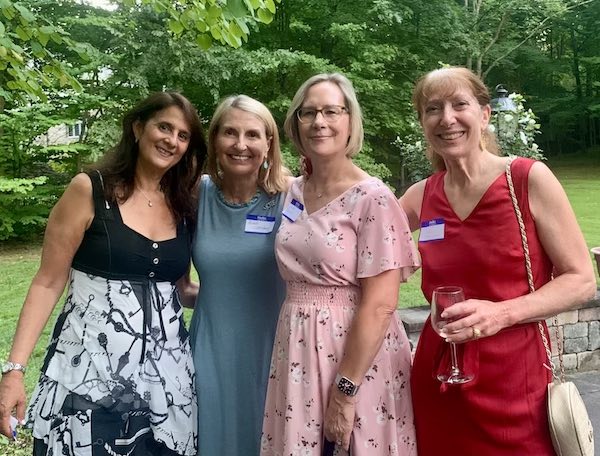 Susan Ross, Michelle Lichtenberg, Laura Daniels and Mona LongmanIf you are a registered Democrat, don’t forget to vote for the candidate of your choice in the August 23 Democratic congressional primary! Please note that the Scarsdale Democratic Town Committee has not endorsed a candidate in this race.
Susan Ross, Michelle Lichtenberg, Laura Daniels and Mona LongmanIf you are a registered Democrat, don’t forget to vote for the candidate of your choice in the August 23 Democratic congressional primary! Please note that the Scarsdale Democratic Town Committee has not endorsed a candidate in this race.
Myra Saul, Chair
Scarsdale Democratic Town Committee
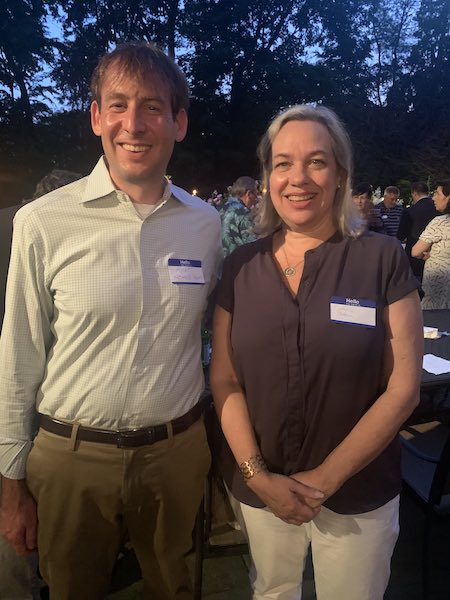 Ron Schulhof and Catherine Parker
Ron Schulhof and Catherine Parker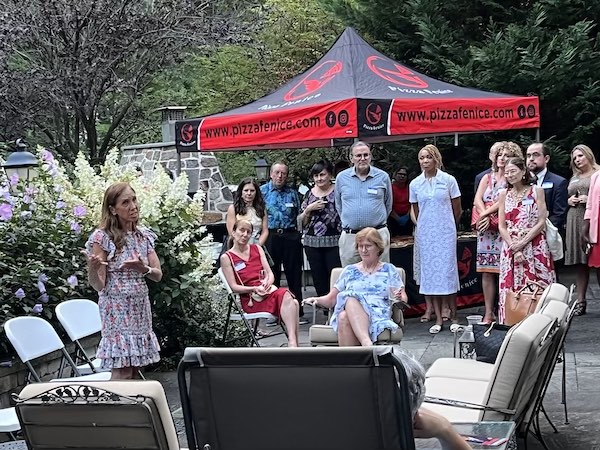 Paulin addresses the group.
Paulin addresses the group.










